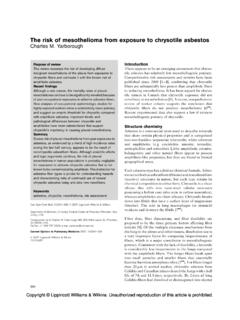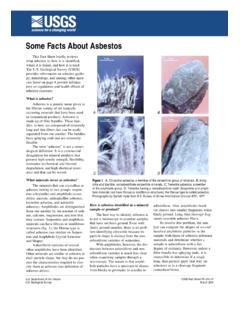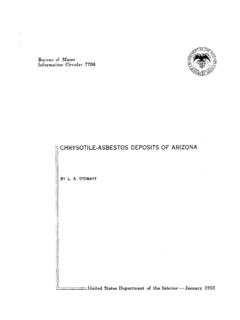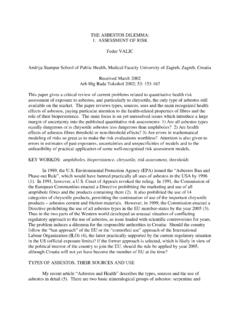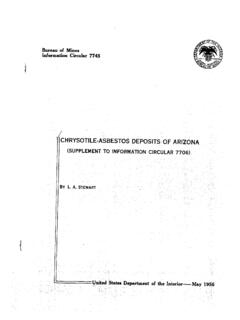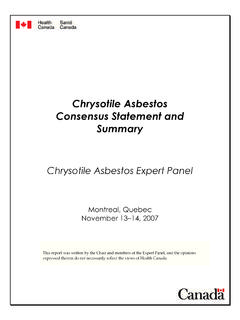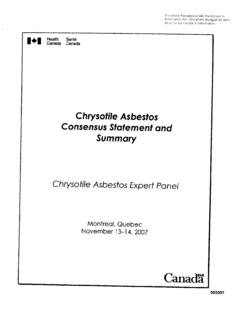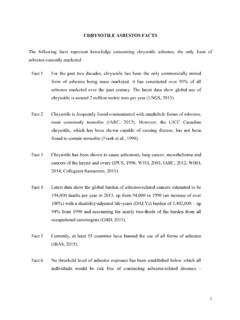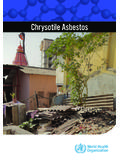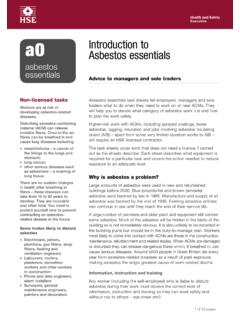Transcription of FREQUENTLY ASKED QUESTIONS ASBESTOS DECISION …
1 FREQUENTLY ASKED QUESTIONSASBESTOS DECISION -MAKING - FLOORINGAs a real estate developer, what building material containing ASBESTOS is most likelyto be found in both commercial and residential properties?Your Right! Flooring materials such as floor tile, vinyl floor sheeting and linoleum are the most frequentlyfound. Good News, removal of these materials only costs $ $ per square foot. Further, in mostcases, flooring materials in good condition and not disturbed by renovations can be left in-place or carpetedover. Many states allow flooring materials to be left in-place during building demolition (do not require priorremoval).
2 Ask your environmental consultant specifics regarding floor tile in your s ASBESTOS Construction Standard 29 CFR requires building and facility owners to treatresilient flooring materials in buildings constructed prior to 1981 as ASBESTOS -containing. Bulk sampling ofthese flooring materials by an accredited inspector (followed by PLM analysis) is the only approved methodto rebut the ACM designation. AET Experience: Exposed flooring materials are easily identified, but flooring materials are often coveredby carpeting or underlayments which limits identifying the exact location and quantities involved.
3 Flooringmaterials are also present in multiple layers and sampling must incorporate all layers down to the floorsubstrate (wood, concrete, etc.). The extent of layering can vary from room to room and usually the bottomlayer (oldest tile) are most likely to contain ASBESTOS . Floor tiles differ in size; 9"x9" tile almost always contain ASBESTOS , 12"x12" tile at least 50% of the timecontain ASBESTOS . ASBESTOS is found in the paper backing of linoleum. Flooring materials containing asbestosusually contain 2-5% chrysotile ASBESTOS . For sampling purposes, flooring materials are classified as miscellaneous suspect materials by the EPA.
4 TheEPA does not establish a minimum sampling requirement for miscellaneous materials to confirm negativeasbestos content but allow the building inspector to utilize his training/experience for this purpose. AETrecommends at least 2 samples of each type of flooring material be tested. Floor Tile Mastics: The adhesive mastic which adheres the flooring materials to the substrate also oftencontains ASBESTOS . Mastics can be ASBESTOS containing regardless if the tile itself contains ASBESTOS . Sufficientmastic must be collected during sampling either on the back of the tile or by taking a separate mastic sampleto ensure proper identification.
5 Mastic associated with sheet vinyl flooring or linoleum are typically crosscontaminated from the residual paper Organically Bound (NOB) Materials: Flooring materials are NOBs and usually contain smallin length, thin in diameter, tightly bound chrysotile ASBESTOS fibers in an asphalt or vinyl matrix. PLManalysis of NOBs does not provide consistently reliable results (false negatives occur). As such, AETrecommends and the states of NY, NJ and SC mandate TEM analysis of flooring material demonstratingnegative ASBESTOS content by : If your building/residence was constructed prior to 1981, it is likely the flooring materialscontain ASBESTOS .
6 Bulk sampling of representative flooring materials is the only way to confirm/denyasbestos content. Flooring materials in good condition do not require removal, but should be managed in-place in your building s Operations and Maintenance ASBESTOS Program. Consult your ASBESTOS consultantprior to disturbing flooring materials, building renovations, building demolition or where damaged flooringmaterials are you need professional help or advice, email Alan Sutherland, CIH, CHMM or call 610-891-0114. We provide nationwide services; phone consultations arefree. Check out the full range of environmental contracting/consulting services on our
